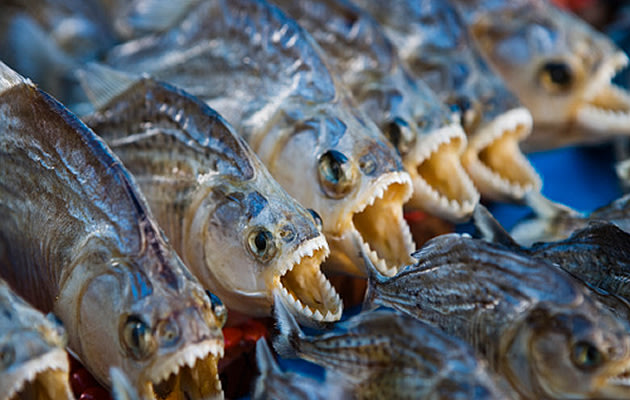Mar 19, 2015 Fish Feeding Frenzy Caught on Camera. Scene from Brazil could be out of a horror movie. “I've been swimming dozens of times in rivers where piranha were very abundant and I've never been.
Attacking a live animal isn't out of the question for piranhas, but it's not likely they could take down a healthy, full-grown human. They have, however, been known to attack sickly, old animals that come to drink from the river. When a cow lowers its head, they'll clamp onto its face. If the cow is too weak to fight back, the piranhas will drag it into the water and eat it. But live prey isn't the mainstay of their diet. Mostly, they're scavengers. The skeletons of animals and people found in the Amazon, apparently eaten by piranhas, weren't attacked alive. They were already dead when the piranhas got to them.


As with other fish, mammals are by no means a big part of the piranha's diet. They eat other fish, mostly, and sometimes other piranhas. An aquarium in Wales that had gone to considerable trouble to acquire a male and a female piranha (piranhas are illegal to import in most parts of the world, including Britain) in hopes the two would mate, were disappointed when the female ate her potential suitor [source: BBC News]. But piranhas aren't strict carnivores. They'll eat fruits and plants, too, especially when they're young.
- Can piranhas really strip a cow to the bone in under a minute? By Julia Layton. Piranha Feeding: The Daily Grind. Most piranhas, like this red-bellied piranha, simply nip at other fish as the pass. Claus Meyer/Minden Pictures/Getty Images.
- Plus, tossing meat in a Brazilian river sets off a ferocious piranha feast. To see these videos in their entirety, click HERE.
Advertisement

Contrary to legend, most piranhas don't really attack anything. Twelve of the 20 species in the Amazon survive entirely on taking small bites out of the fins and scales of other fish as they pass by. The fish swim away only slightly disturbed, and their fins and scales grow back.
While piranhas aren't quite the vicious man-eaters of myth, attacks on humans have been increasing in frequency. In South America, people have been losing fingers and toes more often than they were just 10 years ago, and experts believe it might have something to do with an increase in the number of dams on the Amazon River. Dams slow the current, and piranhas like to breed in the slowest-moving waters. Creating more placid areas along the river is an invitation to piranhas to come set up camp in large numbers. Since placid areas also attract swimmers, humans and piranhas are coming into contact more and more.
For more information on piranhas and related topics, swim through the links on the next page.
Comments are closed.